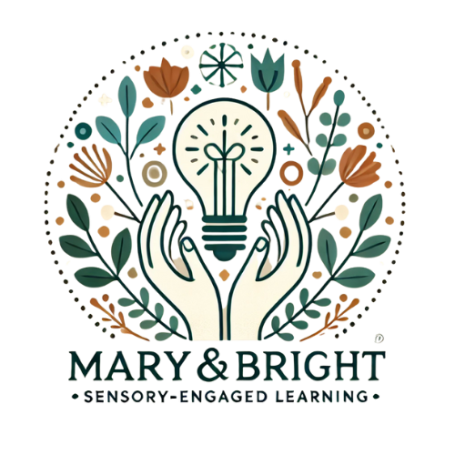Creativity + Science
An in depth look into our approach and how we leverage both science and creativity to exercise and empower your mind and elevate your life!
For the Nerds
At Mary & Bright, our programs are rooted in evidence-based research, blending neuroscience, creativity, and real-world application to transform the lives of older adults and individuals with cognitive impairment. By leveraging sensory engagement and tailored approaches, we aim to stimulate the brain in innovative ways, improve quality of life, and provide meaningful tools for caregivers, families, and professionals.
How Sensory Techniques Radically Engage the Brain
Our programs are designed to stimulate the brain by engaging multiple senses simultaneously and interchangeably. This approach targets key brain regions and networks, including the limbic system (emotional and memory processing), the cerebral cortex (higher-order cognitive functions), the connectome (the brain’s intricate neural wiring), and the default mode network (self-reflection and memory retrieval).
Encourage Neuroplasticity:
Research shows that purposeful multisensory stimulation strengthens and builds new neural pathways, supporting cognitive resilience. For example, sensory-enriched activities like music, scent, and touch have been shown to activate brain regions critical to emotional and cognitive processing (Brain Sciences, 2024; Biomedicines, 2025).
Enhance Emotional and Cognitive Well-Being:
Tailored sensory inputs improve memory recall, reduce agitation, and foster connection. Studies on music-evoked autobiographical memories (MEAMs) demonstrate that familiar music can activate the medial prefrontal cortex, enhancing emotional well-being and communication even in late-stage dementia (Cerebral Cortex, 2009).
Support Cognitive Reserve:
The concept of cognitive reserve suggests that the brain can adapt to and compensate for damage caused by aging or disease. Activities that engage multiple sensory and cognitive pathways build this reserve, potentially delaying the progression of cognitive decline and improving quality of life (Biomedicines, 2025; Brain Sciences, 2024).
Grounded in Science
Music-Evoked Autobiographical Memories (MEAMs):
Music activates the medial prefrontal cortex, a region often preserved in individuals with dementia. Research demonstrates that familiar music improves mood, reduces anxiety, and enhances verbal communication, particularly by stimulating emotional and memory networks (Cerebral Cortex, 2009).
Art and Olfactory-Evoked Memories:
Visual and scent-based stimuli, such as familiar artwork or aromas (e.g., freshly baked bread or flowers), engage the limbic system and sensory processing areas to evoke vivid autobiographical memories. These experiences are particularly effective in reducing agitation and fostering emotional connections (Chemical Senses, 2004).
Validation Therapy:
Validation Therapy, as described by Naomi Feil, emphasizes honoring emotions rather than correcting inaccuracies. This approach fosters trust, reduces anxiety, and aligns with person-centered care principles that promote emotional and relational well-being (Validation: The Feil Method, 1993).
Sensory-Based Neuroplasticity:
Sensory-rich environments have been shown to promote neuroplasticity by stimulating multiple brain regions simultaneously. Activities involving touch, sound, and smell create new neural connections and help maintain cognitive function (Biomedicines, 2025).
Proven Results Backed by Research
Our approach is supported by extensive research and real-world application, delivering measurable outcomes:
- Enhanced neuroplasticity and cognitive function: Sensory stimulation activates critical brain regions and strengthens neural connections (Brain Sciences, 2024).
- Reduced anxiety and agitation: Music and olfactory stimuli calm the limbic system and reduce behavioral symptoms in dementia (Chemical Senses, 2004; Cerebral Cortex, 2009).
- Increased emotional well-being: Multisensory engagement fosters memory recall, mood improvement, and meaningful social interactions (Biomedicines, 2025).
- Empowered caregivers and professionals: Practical, evidence-based tools provide effective strategies for improving quality of life (Validation: The Feil Method, 1993).
Citations
- Feil, Naomi. Validation: The Feil Method. Springer Publishing Company, 1993.
- Herz, Rachel S. "A Naturalistic Analysis of Autobiographical Memories Triggered by Olfactory, Visual, and Auditory Stimuli." Chemical Senses, vol. 29, no. 3, 2004, pp. 217–224, https://doi.org/10.1093/chemse/bjh025.
- Janata, Petr. "The Neural Architecture of Music-Evoked Autobiographical Memories." Cerebral Cortex, vol. 19, no. 11, 2009, pp. 2579–2594, https://doi.org/10.1093/cercor/bhp008.
- "Sensory Diets in Dementia Care: A Review of Neuroplastic Potential." Brain Sciences, vol. 14, 2024, https://doi.org/10.3390/brainsci14030285.
- "The Role of Multisensory Stimulation in Dementia Rehabilitation: A Systematic Review." Biomedicines, 2025, https://doi.org/10.3390/biomedicines13010149.
- Brown University. "Non-Pharmacological Interventions for Alzheimer's: Improving Quality of Life and Reducing Costs." Brown University Research Updates, 2023.
At Mary & Bright, we are committed to bridging science and care by translating complex research into practical, transformative strategies for caregivers, families, and professionals. Together, we’re shaping brighter, more connected futures for individuals and their loved ones.








©Copyright. All rights reserved.
We need your consent to load the translations
We use a third-party service to translate the website content that may collect data about your activity. Please review the details in the privacy policy and accept the service to view the translations.
